What is a Board Resolution and when is it required?
A board resolution is a record of decisions made by the Board of Directors during a board meeting.
A company is a hierarchical structure of multiple stakeholders. Shareholders, investors, directors, advisors, consultants, and employees, each one of them having well-defined roles which culminate in a company’s performance. And a chain of command has to be followed throughout these levels to keep the business moving forward like a well oiled machine, which is where the role of company directors fits in.
This article outlines the basics of this documentation process. Let us try to understand why such board resolutions are important and how to create them. We begin by exploring “What is a board resolution?”.
Company Board Resolution
A company director is vested with significant power to run the business. Though appointed by the shareholders, the Board of Directors as a collective is powerful enough to become a risk to the shareholders if they become reckless in their decision making or act out of personal interest. Bad decisions will directly impact the business and in turn, affect the share value. Thus to protect the interest of shareholders, director duties are created in such a way that they are legally binding, with a board resolution being one such legally binding structures.
What is a Board Resolution?
A board resolution is a record of decisions made by the Board of Directors during meetings. It is a formal document that identifies the roles of all corporate officers and their votes over a particular decision concerning the welfare of a company. It is used to pen down every minute detail of the board meeting. It is usually certified by the appointed chairperson and duly signed by all board members present at the meeting. It is maintained along with the meeting minutes and is a legally binding decision of every S Corporation or C Corporation. Here is how a typical board resolution looks:
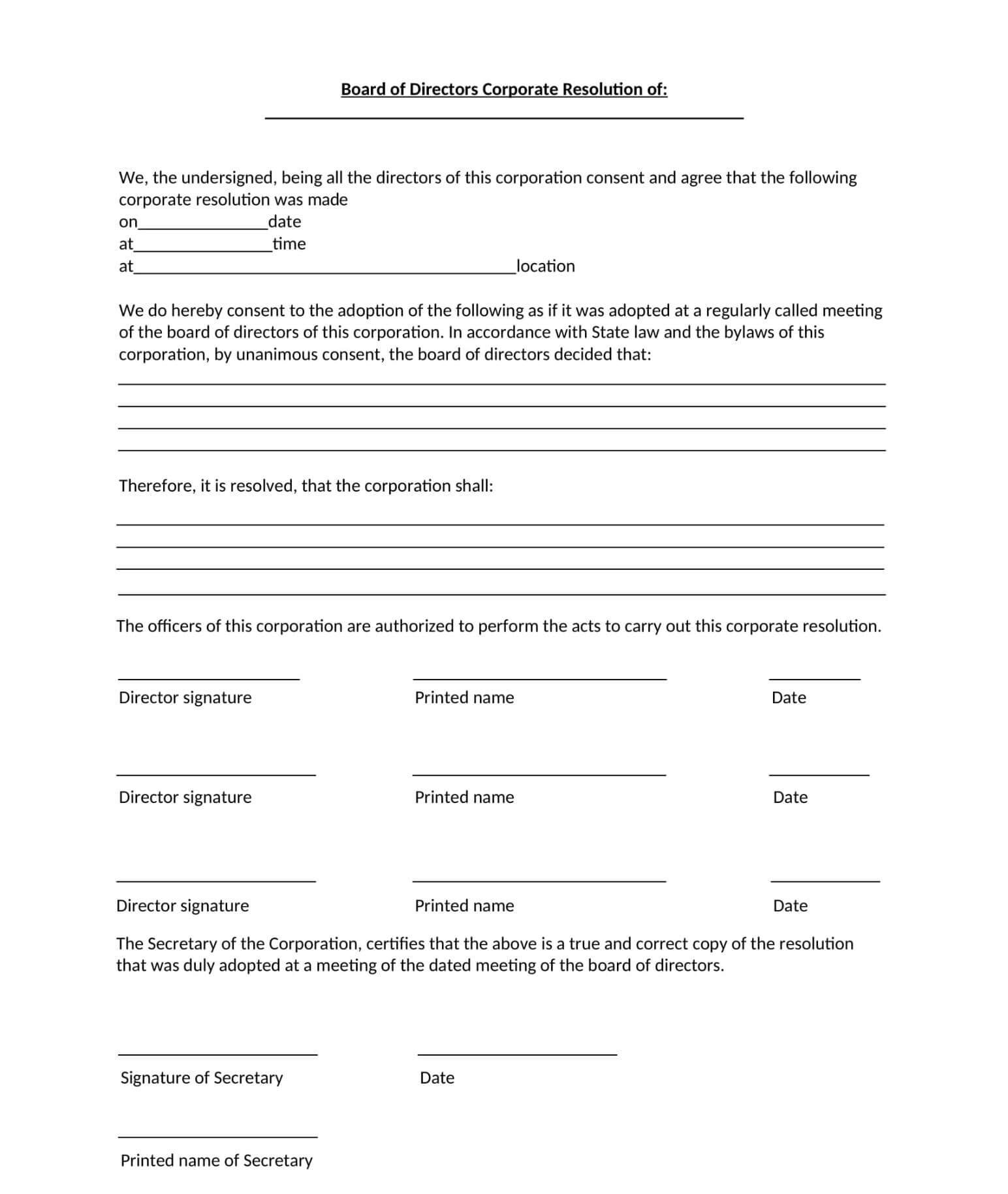
Here are the key requirements to pass a valid board resolution:
| Proper Notice and Agenda | |
| Quorum | |
| Voting Threshold | |
| Voting Procedures | |
| Certification | |
| Record -Keeping | |
| Filing requirements |
Requirements to pass a Board Resolution
The directors are responsible for making the overall corporate decisions and don’t usually get involved in the company’s day-to-day operations. Board resolutions percolate down the company hierarchy and are implemented by the respective business units. Hence board meetings are not a casual, daily affair.
When is a Board Resolution required?
There is no mandate to submit board resolutions to a government agency or any other supervising entity. It is maintained for self-assessment within the company or in case any of the important shareholders want to verify the actions which the directors have taken on their behalf. Alternatively, some institutions like banks, brokerage firms, the IRS, or the court may demand copies as part of their audit/verification procedures.
Primarily a board resolution is needed to keep a record of two things:
- To record decisions concerning company affairs (except for shares) made in the board of directors meeting.
- To record decisions concerning company equity made by shareholders of the corporation. This is also known as a company resolution.
Some companies may have a separate board for directors and shareholders, but most corporations comprises a combination of large shareholders, equity partners, directors, and other senior officers. The extent of their voting rights is laid out in their respective agreements. In such cases, board resolutions are alternatively known as company resolutions.
The most important decisions requiring a board to convene are:
- Voting in new members
- Need to expand, hire or let go of a large number of employees
- Sell shares of a corporation
- Matters concerning intellectual property rights
Types of Board Resolution
A board resolution is subject to voting ‘yes’ or ‘no’. This can be done by a show of hands, chits, or by electronic means. The simple principle of a ‘majority’ dictates the passing of a resolution. However, based on the criticality of a proposal, a percentage of the majority required to pass a resolution may vary.
| Types of Resolution | Description | Voting Threshold | Used For |
|---|---|---|---|
| Ordinary Resolution | Routine Matters | Simple Majority (>50%) | |
| Special Resolution | Significant /Constitutional matters | Super Majority (75% or higher) | |
| Unanimous Resolution | Critical matters | 100% approval required | |
| Written Resolution | Can be ordinary or special | Follow thresholds for ordinary/special resolutions |
Ordinary resolutions
When a board resolution is passed by a simple majority, it is called an ordinary resolution. Votes cast in favor are more than the ones against. A resolution with a majority of just over 50% of the quorum is considered passed. For example, 6 ‘yes’ votes out of 10 are considered a majority. Matters qualifying for ordinary resolutions are:
- Director election
- Auditor appointment
- Dividend declaration
- Fixing remuneration
- Alteration in authorized capital
Special resolutions
When board resolutions require a higher majority, they fall under a special category. Prior initiation should be given before convening with a special resolution agenda. The company constitution pre-determines the majority percentage, being common to set it at 75% or higher. Critical matters that require a special resolution by the board are:
- Change in the company’s registered office from one state to another.
- Alterations in the object clause of the memorandum
- Alterations in the Articles of Association
- Reduction in the company’s share capital
Unanimous resolutions
As the name suggests, these require 100% votes from the quorum, however these are uncommon. With more board members, it becomes logistically difficult to convene such meetings. An extreme example of a proposal requiring a unanimous resolution is shutting down the company. Apart from such catastrophic situations, most resolutions are subject to the ‘ordinary’ or ‘special’ format.
When are Board Resolutions considered ‘decided’?
Despite securing the board’s majority, a resolution may run the risk of being disqualified. This happens when certain guidelines are not complied with. A Board Resolution is only valid when:
- The meeting has been properly convened with prior intimation as per Company bylaws.
- The board properly holds the resolution and quorum is maintained.
- Duly certified and signed by the appointed chairperson
- The new resolution finds its way into the company books within one month of the board meeting.
Board resolutions are part of the meeting minutes. This means that a board secretary is appointed to judiciously note all proceedings of the meeting. However, documented as conversations and standard guidelines determine the resolution structure.
How to Write A Board Resolution?
A board resolution, though not a legal document, is formal and the decisions made by the board are legally binding. Hence, it follows a particular pattern and demands a certain language in its composition. Let us first take a look into what comprises a basic Board Resolution format:
- Date of the Meeting
- A serial number of the document. Eg. 001, 002, and so on
- Appropriate title. Eg. Board Resolution for Appointment of Director of Operations of ABC Inc.
- Each paragraph begins with a formal ‘Whereas’
- The first sentence declares the Board’s responsibility. Eg. “Whereas it is the Board’s responsibility to appoint a Director……”
- The last statement states the final resolution. It is the action taken regarding the proposal. Eg. “Now, therefore it resolved to appoint Mr. X as the Director of Operations of ABC Inc.”
- At the bottom, the names of all directors are listed with an adjacent column to record their votes as ‘yes’ or ‘no’. A resolution is approved only when the majority votes are ‘yes’
- Finally, at the end of the document, space is created for the meeting chairperson’s signature and date of the board resolution.
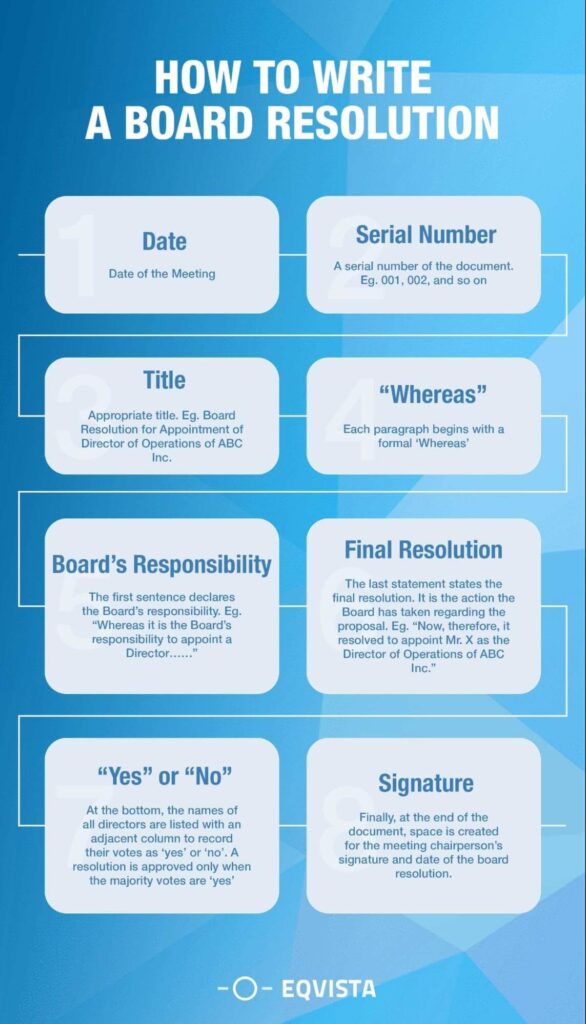
Tips for writing your Board Resolution
- Identify the issue with the utmost clarity. Keep it as simple as possible
- Research the issue in detail
- Ensure that the local state or federal government agencies have not already realized the issue
- Create a section supporting the statements
- Mention policies related to the issue
- Provide truthful and verifiable references and sources
In an ideal scenario, board resolutions are passed in a board of directors meeting where directors are present. However, in the increasingly globalized marketplace, it might become impossible to wait for directors to be physically present for every meeting, even to suit quorum requirements. Adopting the electronic medium today is ideal, seamless, time-saving, and ensures transparency at all levels.
How to Create your Board Resolution on Eqvista
You can now create your Board Resolutions on Eqvista and share it with your board members for voting. Eqvista’s sophisticated equity management software allows companies, investors, and company directors to hold meetings for the company. Here are the steps to create and share a Board Resolution using Eqvista:
Step 1: On the left side menu of the dashboard, click on “Admin Records” and then on “Board resolutions”.

You will be redirected to a new window to create new board resolutions.
Step 2: Click on “Create Resolutions” to create a new resolution.
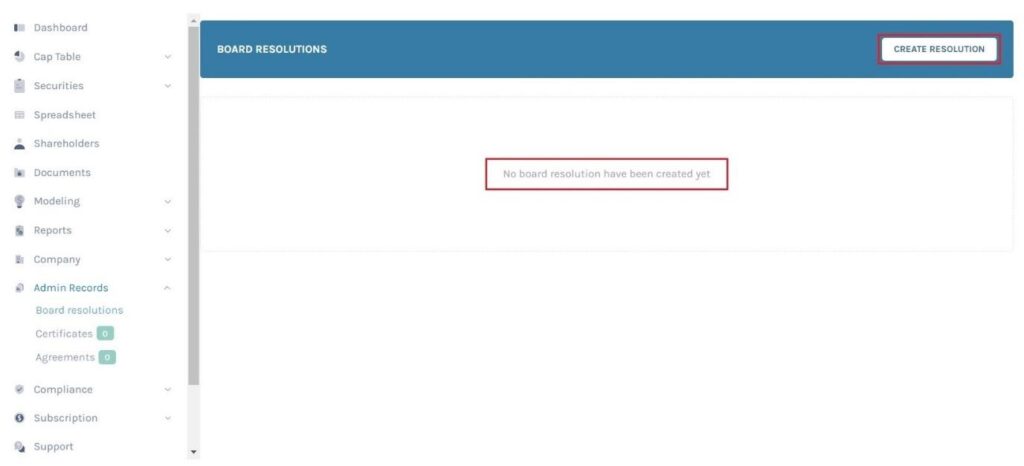
You will get a new interface to create your desired board resolutions. For example, here we create a board resolution for selecting the board chairman of a “Core Tech“ company.
Please include the consent details and attach relevant documents if needed.
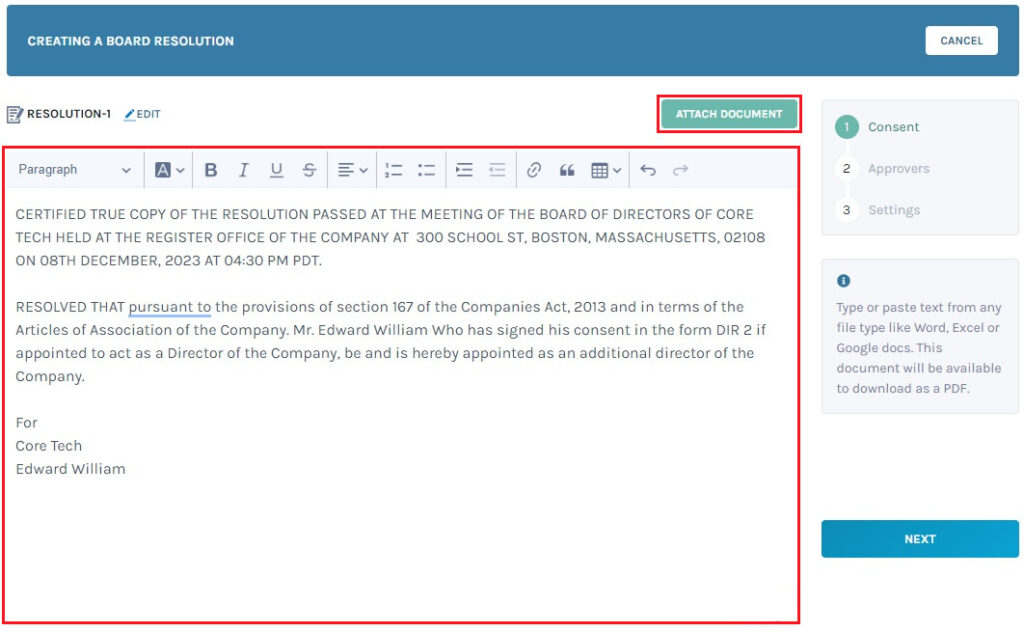
Once you are done, click “Next”.
Step 3: Set up the approvers of the board resolution
Founders will be automatically added through the app. Add the “Extra Approvers” for consent by searching through the company’s shareholder list. In this example, we add another investor “Clara John” to the list.

Once you click “ADD” it will be added to the “APPROVERS” list.
Similarly, if you have more approvers you can add it as above. Once you finish adding approvers click “Next”.
Step 4: Add an “EXPIRATION DATE” and “EMAIL MESSAGE” to be sent.
The approver can also vote on this resolution openly or anonymously, which can be set in “PRIVACY SETTINGS”.

Once you click the “Submit” button, this resolution will be sent via email to all the approvers for voting. The approvers will get an invitation link to the particular resolution and they can vote for this to pass this resolution.
Step 5: Check the status of this resolution.

If you click on the board resolution here, you will be taken to the following page where you can see the details of the resolution passed along with the three options – Approve, Decline, and Abstain.
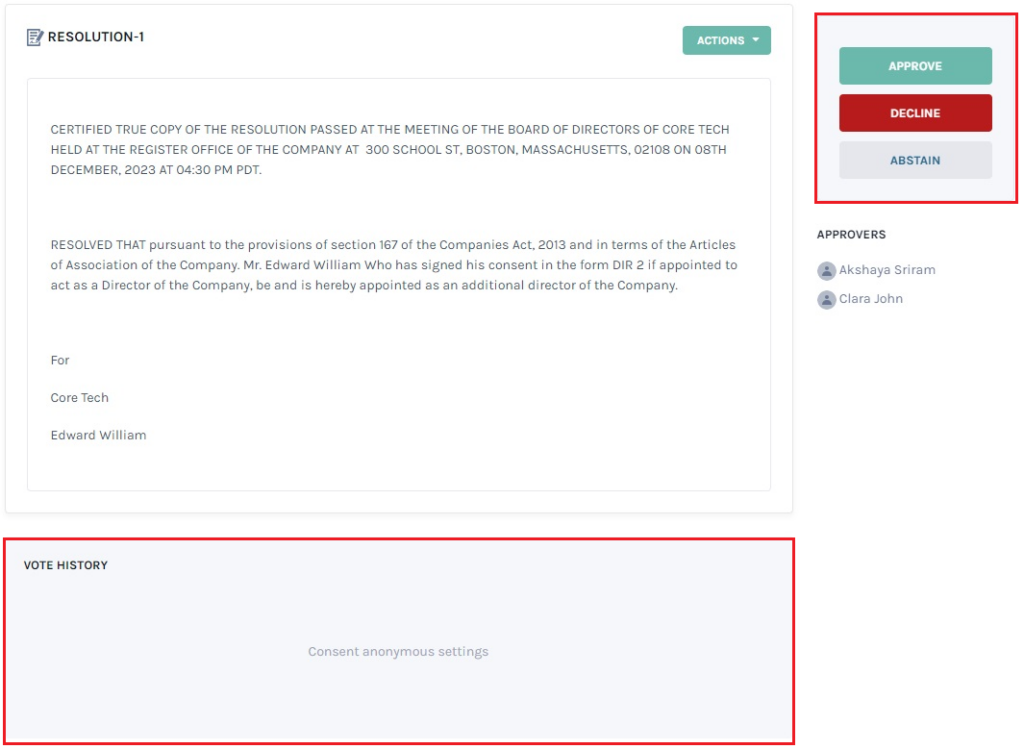
You can see the overview of the resolution, vote history, and other relevant details.
Start Creating a Board Resolution on Eqvista Today!
Board resolutions are crucial for maintaining a legal record of the decisions, ensuring accountability, and protecting the board members from liability. They are essential for good governance and provide proof that the board is fulfilling its responsibilities efficiently and responsibly.
Eqvista provides a comprehensive platform for creating, sharing, and managing board resolutions. Using Eqvista provides a structured, secure, and efficient way to handle important corporate decisions, especially in a globalized and increasingly digital business environment. Get started today!
Interested in issuing & managing shares?
If you want to start issuing and managing shares, Try out our Eqvista App, it is free and all online!
